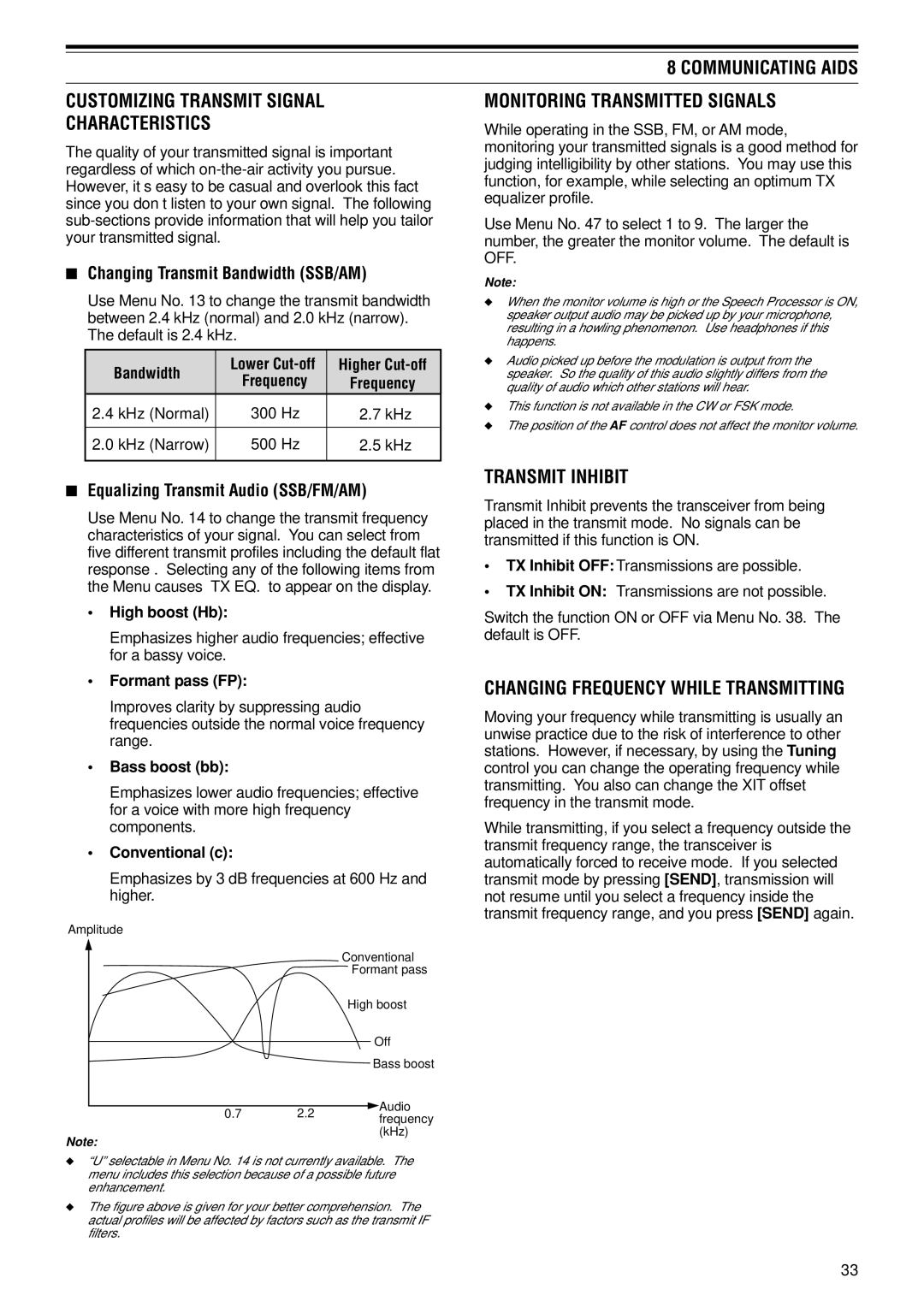
8 COMMUNICATING AIDS
CUSTOMIZING TRANSMIT SIGNAL
CHARACTERISTICS
The quality of your transmitted signal is important regardless of which
■Changing Transmit Bandwidth (SSB/AM)
Use Menu No. 13 to change the transmit bandwidth between 2.4 kHz (normal) and 2.0 kHz (narrow). The default is 2.4 kHz.
Bandwidth | Lower | Higher | |
Frequency | Frequency | ||
| |||
2.4 kHz (Normal) | 300 Hz | 2.7 kHz | |
|
|
| |
2.0 kHz (Narrow) | 500 Hz | 2.5 kHz | |
|
|
|
■Equalizing Transmit Audio (SSB/FM/AM)
Use Menu No. 14 to change the transmit frequency characteristics of your signal. You can select from five different transmit profiles including the default flat response . Selecting any of the following items from the Menu causes “TX EQ.” to appear on the display.
•High boost (Hb):
Emphasizes higher audio frequencies; effective for a bassy voice.
•Formant pass (FP):
Improves clarity by suppressing audio frequencies outside the normal voice frequency range.
•Bass boost (bb):
Emphasizes lower audio frequencies; effective for a voice with more high frequency components.
•Conventional (c):
Emphasizes by 3 dB frequencies at 600 Hz and higher.
Amplitude
Conventional
Formant pass
High boost
Off
Bass boost
Audio
0.7 2.2frequency (kHz)
Note:
◆“U” selectable in Menu No. 14 is not currently available. The menu includes this selection because of a possible future enhancement.
◆The figure above is given for your better comprehension. The actual profiles will be affected by factors such as the transmit IF filters.
MONITORING TRANSMITTED SIGNALS
While operating in the SSB, FM, or AM mode, monitoring your transmitted signals is a good method for judging intelligibility by other stations. You may use this function, for example, while selecting an optimum TX equalizer profile.
Use Menu No. 47 to select 1 to 9. The larger the number, the greater the monitor volume. The default is OFF.
Note:
◆When the monitor volume is high or the Speech Processor is ON, speaker output audio may be picked up by your microphone, resulting in a howling phenomenon. Use headphones if this happens.
◆Audio picked up before the modulation is output from the speaker. So the quality of this audio slightly differs from the quality of audio which other stations will hear.
◆This function is not available in the CW or FSK mode.
◆The position of the AF control does not affect the monitor volume.
TRANSMIT INHIBIT
Transmit Inhibit prevents the transceiver from being placed in the transmit mode. No signals can be transmitted if this function is ON.
•TX Inhibit OFF: Transmissions are possible.
•TX Inhibit ON: Transmissions are not possible.
Switch the function ON or OFF via Menu No. 38. The default is OFF.
CHANGING FREQUENCY WHILE TRANSMITTING
Moving your frequency while transmitting is usually an unwise practice due to the risk of interference to other stations. However, if necessary, by using the Tuning control you can change the operating frequency while transmitting. You also can change the XIT offset frequency in the transmit mode.
While transmitting, if you select a frequency outside the transmit frequency range, the transceiver is automatically forced to receive mode. If you selected transmit mode by pressing [SEND], transmission will not resume until you select a frequency inside the transmit frequency range, and you press [SEND] again.
33
